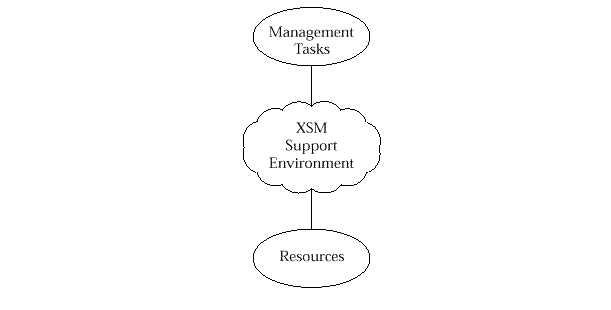
The Reference Model does not specify what Management Tasks or Resources exist, and it does not make any restrictions on how Management Tasks and Resources interact, although it does permit a many-to-many interaction. The purpose of XSM is to provide an environment that will permit Management Tasks to be constructed in a way that encourages portability from one conformant system to another and interoperability between heterogeneous systems.

XSM is based on the exploitation of several concepts, all of which are required to enable Systems Management to take place. These concepts are:
Management Tasks do not appear explicitly within the Reference Model. However, they are the essential functionality that the Model exists to support. The Model provides the framework necessary to support the various components that need to exist in order to implement the operations that are represented by Management Tasks.
An example of a Management Task is adding a user, which involves the creation and manipulation of several different Resources within the system.
The definition of Management Tasks is outside the scope of the Reference Model, which is primarily concerned with the underlying functionality required to implement a rich set of Management Tasks.
General Services are the normal range of services available to all applications. They include services such as file and process manipulation, device input/output services, and basic security mechanisms.
Management Services are the common management functionality available to all management applications. They are typically built upon common underlying system services and management specific services. Examples of Management Services include security services, consistency services, collection services, and event services.
These concepts will be realised as concrete implementations using the specifications of XSM as defined in the suite of XSM documents.
The basis of XSM is the manageability of system Resources.
The Resources that are to be managed represent the
capability of systems to perform functions which,
ultimately, are of benefit to users. Some Resources
represent capabilities that are of direct benefit
to users and, hence, are directly consumed by users.
Such Resources present users with a functional
interface and participate in functional interactions.
These represent the normal (non-management)
activity of the Resource, the reason for which the
Resource exists. This is shown in
Other Resources exist that aid in the management or consumption of Resources on the system or in the network. Such Resources may present little or no functional interfaces, and only take part in management interactions.
For a Resource to be managed it must provide a management interface
and take part in management interactions such that it becomes a
Managed Resource.
In

XSM does not specify what form functional interfaces may take, nor which standards (if any) they will adhere to. There is no implication that methods used to define the management interface should be used to define the functional interface.
The functional and management interfaces are quite separate, the interactions taking place independently of each other. However, the results of one type of interaction may affect the way in which the Resource performs the other interaction. Therefore, a management interaction may affect the functional operation of the Resource and thereby its functional interactions, and vice versa. For example, some activity at the functional interface may cause an alarm notification to be sent to a Manager using the management interface, or an operation at the management interface may change the configuration of the Resource causing it to respond differently at the functional interface. The way in which this relationship between management interface and functional interface operates is outside the scope of XSM, being a function of the Resource itself and the way in which its management interface and its interpretation of the management interactions are defined.
| Contents | Next section | Index |